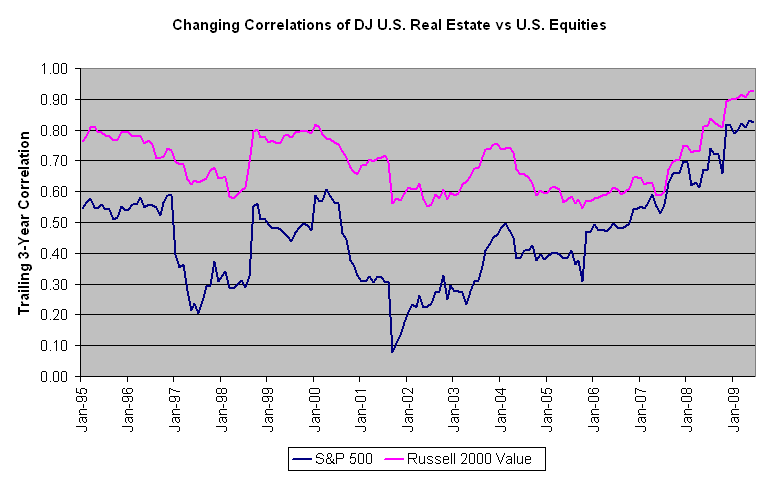REITs And Your Portfolio
Post on: 30 Март, 2015 No Comment

January 7, 2014 By Rick Ferri
Real estate investment trusts (REITs) have unique characteristics that make them a great portfolio diversifier. The performance of REITs has been on par with US common stocks; however, the correlation of return has varied from low to high. The non-linear return relationship of REITs to common stocks has provided a return benefit to investors over the past 20 years.
REITs are divided into two basic categories: equity and mortgage. Equity REITs invest almost exclusively in real estate properties. Mortgage REITs do not own property directly they finance properties through commercial loans. Mortgage REITs are basically a type of bond investment rather than a real estate investment. This article focuses exclusively on equity REITs.
Equity REIT index funds are a convenient way to own a broadly diversified portfolio of properties. There are approximately 157 different equity REITs that trade on the U.S. stock market according to FTSE NAREIT. The Vanguard REIT ETF (ticker: VNQ) invests in 131 REITs that are large enough to trade. This fund, as with other REIT index funds and exchange-traded funds (ETFs), provide investors with a wide variety of properties, including shopping malls, office complexes, apartment buildings, hotels, etc.
US Equity REITs have a market capitalization of about $605 billion according to FTSE NAREIT. This is about 3% of the total US stock market of which the REIT market is a part of. Commercial real estate represents about 13% of the US economy. Thus, if you desire a portfolio that represents the economy, the asset class is underrepresented by about 10% in the stock market.
REITs are a unique asset class and should be treated as such. In my book, All About Asset Allocation. I outline the criteria for the potential inclusion of separate asset classes in a portfolio. For a basket of securities to be considered a separate asset class in a portfolio, it must be:
- Fundamentally different than other asset classes. REITs have unique characteristics from common stocks. They’re the collateralization of several individual properties, have a unique tax structure where the trust pays no federal tax, and the correlation of REITs indices with common stocks varies this confirms a unique risk.
- Provide a positive real return over time. REITs have a positive real expected return due to a combination of rental income and income growth. Landlords pass inflation increases to tenants based on a general level of price increases and this gives real estate owners a built-in inflation hedge. The value of real estate eventually reflects higher rents through higher prices.
- Available in a diversified, liquid, low-cost investment product. An asset class must be investible and liquid. There are many REIT index funds and ETFs available to investors. These funds have daily liquidity and the cost to invest is very low.
A correlation analysis helps get past the first screen, fundamentally different than other asset classes. A rolling correlation analysis measures the dependency that one asset class has on the return of another over the long-term. Low correlation and varying correlation signals a low dependency, which implies the presence of unique risk in the asset class.
Figure 1 illustrates the 36-month rolling correlation between the CRSP Total Stock Market Index and the Dow Jones Select REIT Index. an all equity REIT index representing trusts with at least $200 million in market capitalization. The unique risk in REITs is evident in the figure in the form of high variability.
Figure 1: Rolling 36-month correlation between US stocks and REITs
Source: Correlations Calculated by Rick Ferri using CRSP Total Return and S&P Dow Jones Select REIT as reported by Dimensional Fund Advisors.
Equity REITs are baskets of real estate properties that trade on a stock exchange. They offer investors an easy and liquid way to participate in the equity real estate market. Second-by-second public market pricing does have volatility due to varying supply and demand. This can be overcome by holding REITs for the long-term.
A 10% allocation in a REIT index fund shifts a market weight holding of REITs closer to an economic allocation. See my work on the Total Economy Portfolio for more information on this strategy. A tilt toward REITs has added to portfolio return over time.
Figure 2 illustrates the return difference between one total US stock market index and a combination of 90% CRSP Total Stock Market Index and 10% in the Dow Jones Select Real Estate Index. The index includes all-equity REITs with at least $200 million in market capitalization.
Figure 2: Adding 10% in REITs has aided portfolio returns historically (Jan. 1996-Oct. 2013)
Source: Returns calculated by Rick Ferri using CRSP Total Return and S&P Dow Jones Select REIT as reported by Dimensional Fund Advisors.
Adding a unique asset class to a portfolio that has positive real returns and low or varying correlation with common stocks helps increase long-term returns. A well-diversified portfolio that holds an economic allocation to REITs has shown to be a more efficient portfolio than one that includes a market-weight allocation.
One disadvantage of REITs is the way they are taxed. Since federal taxes are not collected on the company level, the dividends from REITs are taxed as regular income on an individual tax return. This may make the investment less than optimal in a taxable account for investors in a high federal tax bracket.
Equity REIT index funds are a liquid and convenient way to increase commercial real estate allocation.
Several low-cost REIT index funds and ETFs are available that provide instant diversification across the entire commercial real estate market. See All About Asset Allocation for more information on the benefits of adding real estate to your investment portfolio.














